With only six days to spend in Cambodia, we planned to focus on its major destinations: the capital city of Phnom Penh, and the Angkor Wat area around Siem Riap. When our friend Vanessa, a former Peace Corps Thailand volunteer and current Cambodia resident, told us she’d be in the small town of
Kampong Cham during our visit, however, we decided it was worth making a short detour to a less-visited spot. It was well worth the effort.
We arrived in KC hungry after spending hours on the bus, so we rushed out to one of Vanessa’s recommended restaurants on the river road. There are two places along the river, both owned by foreigners, that serve a combination of Western and Cambodian food. We went to the one closer to
our hotel.
I think we shocked the owner a bit with our appetites, and then we were shocked ourselves by the amount of food that arrived at our table. We feasted on vegetarian spring rolls,
amoc, and stir-fried vegetables with tofu.
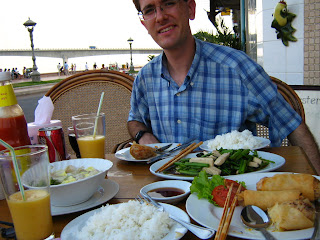
I also enjoyed a mango shake. Yum!
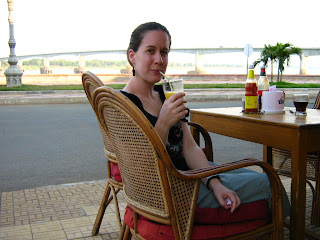
Dining on the Mekong River was pleasant as usual, and some excitement occurred when a political parade suddenly came along. Dozens of trucks and hundreds of motorcycles, all filled with cheering, singing, laughing Cambodians in light blue shirts, streamed by. We were impressed by both the enthusiasm of the political expression and the relative calmness of the parade as a whole, as in Thailand such events are usually marked by excessive drunkenness. We waved and clapped for the riders.
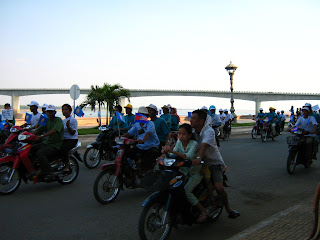
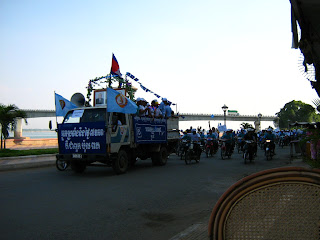
Vanessa was working a temporary contract with Peace Corps Cambodia, which just started in January (hooray!), as a trainer for the newly arrived volunteers. We met her and one of her fellow trainers, a long-time Peace Corps international staff person from Nepal, at the riverside park across the street from our hotel. Over Angkor beer, they told us some of the stories of the new Cambodia volunteers.
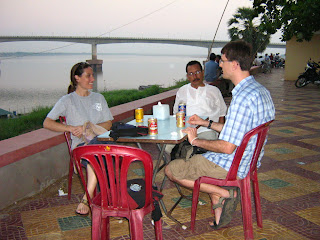
Despite the size of our earlier meal, we were hungry enough to wander down to the second of Vanessa’s two favorite restaurants with her after dark. Robert tried one of the traditional Cambodian beef dishes, which he reported was delicious, while I had a simple vegetable curry. Vanessa told us more about Cambodia and its problems, which we appreciated learning because as tourists it’s often difficult to see behind the outer facade of daily life.
Among some of the issues we discussed were the relative dangerousness of life, in particular at night; the astounding corruption that occurs at all levels of government and business; the marked gap between the extremely wealthy and the rest of the population; and the continuing effects of the
Khmer Rouge regime and genocide.
Of all her stories, the ones about corruption were most disturbing to me. Because she had been working closely with the new volunteers and their Cambodian counterparts, she had many stories about how corruption was manifested at the school level. Teachers make just $45 per month in Cambodia, which is an astonishingly small amount, even in this poor country. As a result, teachers spend a majority of their time trying to make money from activities other than teaching, such as attending paid workshops, doing paid tutoring, or working at other jobs. Students are charged for the paper on which they take tests, because the teachers have to buy it out of their own pocket. School is closed far more often than it’s open – in the two months that the trainees had been in Kampong Cham, school had only been open for four days. And summer break was still weeks away.
I thought the school system was bad in Thailand, and it is, but Cambodia made Thai education look like a stellar example. I was constantly frustrated when classes were cancelled on a weekly basis in Thailand, but I can’t imagine the frustration I’d face if they were cancelled every day! It’s hard to know what hope there is for a country in that situation. You’ve got to have a critical mass of people who are interested enough in making things different for it to actually happen. Because of the way that corruption works in Cambodia, enabling people who take advantage of the system to be better off than those that want to make it work, it looks like there won’t be much improvement any time soon. We’d never have known all this about Cambodia just from being tourists. It is really worth it to spend time talking with someone who knows what going on, down on the level of the real people!